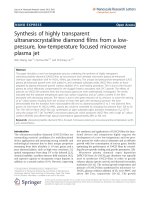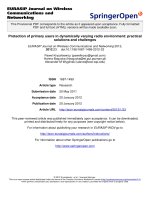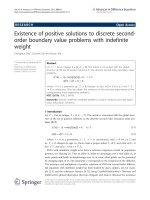Báo cáo toán học: " Growth of few-wall carbon nanotubes with narrow diameter distribution over Fe-Mo-MgO catalyst by methane/acetylene catalytic decomposition" pptx
Bạn đang xem bản rút gọn của tài liệu. Xem và tải ngay bản đầy đủ của tài liệu tại đây (4.37 MB, 20 trang )
Nanoscale Research Letters
This Provisional PDF corresponds to the article as it appeared upon acceptance. Fully formatted
PDF and full text (HTML) versions will be made available soon.
Growth of few-wall carbon nanotubes with narrow diameter distribution over
Fe-Mo-MgO catalyst by methane/acetylene catalytic decomposition
Nanoscale Research Letters 2012, 7:102
doi:10.1186/1556-276X-7-102
Vladimir A Labunov ()
Alexander S Basaev ()
Boris G Shulitski ()
Yuriy P Shaman ()
Ivan Komissarov ()
Alena L Prudnikava ()
Beng KANG Tay ()
Maziar Shakerzadeh ()
ISSN
Article type
1556-276X
Nano Express
Submission date
6 December 2011
Acceptance date
2 February 2012
Publication date
2 February 2012
Article URL
/>
This peer-reviewed article was published immediately upon acceptance. It can be downloaded,
printed and distributed freely for any purposes (see copyright notice below).
Articles in Nanoscale Research Letters are listed in PubMed and archived at PubMed Central.
For information about publishing your research in Nanoscale Research Letters go to
/>For information about other SpringerOpen publications go to
© 2012 Labunov et al. ; licensee Springer.
This is an open access article distributed under the terms of the Creative Commons Attribution License ( />which permits unrestricted use, distribution, and reproduction in any medium, provided the original work is properly cited.
Growth of few-wall carbon nanotubes with narrow diameter distribution over
Fe-Mo-MgO catalyst by methane/acetylene catalytic decomposition
Vladimir A Labunov*†1, Alexander S Basaev2, Boris G Shulitski1, Yuriy P
Shaman†1,2, Ivan Komissarov1, Alena L Prudnikava*1, Beng Kang Tay3, and Maziar
Shakerzadeh3
1
Belarusian State University of Informatics and Radioelectronics, P. Brovki 6, Minsk
220013, Republic of Belarus
2
SMC (Technological Centre), Zelenograd, Moscow 124 498, Russia
3
School of Electrical and Electronic Engineering, Nanyang Technological University,
Singapore 639798, Singapore
*Corresponding authors: ;
†
Contributed equally
Email addresses:
VAL:
ASB:
BGS:
YPS:
IK:
ALP:
BKT:
MS:
-1-
Abstract
Few-wall carbon nanotubes were synthesized by methane/acetylene decomposition
over bimetallic Fe-Mo catalyst with MgO (1:8:40) support at the temperature of
900°C. No calcinations and reduction pretreatments were applied to the catalytic
powder. The transmission electron microscopy investigation showed that the
synthesized carbon nanotubes [CNTs] have high purity and narrow diameter
distribution. Raman spectrum showed that the ratio of G to D band line intensities of
IG/ID is approximately 10, and the peaks in the low frequency range were attributed to
the radial breathing mode corresponding to the nanotubes of small diameters.
Thermogravimetric analysis data indicated no amorphous carbon phases. Experiments
conducted at higher gas pressures showed the increase of CNT yield up to 83%.
Mössbauer spectroscopy, magnetization measurements, X-ray diffraction, highresolution transmission electron microscopy, and electron diffraction were employed
to evaluate the nature of catalyst particles.
Introduction
Carbon nanotubes [CNTs] due to their incredible properties have attracted scientific
and practical interest for almost 20 years [1]. High electrical and thermal conductance,
striking mechanical strength, and an especially unique chirality-dependence electronic
structure make CNTs one of the most promising alternatives to replace some of
today's materials used in microelectronics manufacturing. In particular, due to an
enormous field enhancement factor and high conductivity, CNTs are perfect sources
for electron emission [2]. Tremendous numbers of attempts have been made to use
carbon nanotube arrays as the field-emission cathodes [FECs] [3]. Single-wall carbon
nanotubes [SWNT] provide a large field enhancement factor, low threshold voltage,
and high emission currents, but the substantial degradation of emission currents is a
serious bottleneck for the application of SWNT-based FECs [4]. In contrast, multiwall carbon nanotubes [MWNTs] have high emission stability but have a small field
enhancement factor. Few-wall carbon nanotubes [FWNTs] are considered as an ideal
choice for this application [5]. Despite the progress in producing high-impurity and
high-yield few-wall CNTs [6], the cost and simplicity of CNT fabrication still remain
as the major problems limiting their wide application. In general, the main methods of
CNT synthesis are arc discharge, pulsed laser ablation, and chemical vapor deposition
[CVD]. CVD method has been recognized as the most suitable for commercial
production of CNTs. The use of large specific surface powder with catalytic sites
distributed on it is the common approach for high-yield CNT processes. Fabrication
of a catalyst for synthesis of CNTs with desired geometrical properties (number of
walls) is the art of today's carbon nanotube technology.
So far, bimetallic catalysts are accepted as the most efficient for high-yield production
of CNTs. Metal alloys such as Co-Ni [7], Fe-Co [8, 9], Fe-Mo [6, 10], and Co-Mo
[11, 12] were utilized in catalysts for CNT growth. There are a number of works
discussing the transition metals: molybdenum ratio and role of molybdenum in the
efficient growth of CNTs with uniform diameter distribution [13-16]. A high amount
of molybdenum in Fe-Mo alloy leads to the growth of larger-diameter CNTs, and vice
versa, decreasing the Mo content in bimetallic alloy favors smaller-diameter CNT
synthesis. This fact most likely relates to the catalytic particle size dependence on
FexMoyOz phases from which these particles are released during the reduction
process; in turn, oxide phase formation depends on calcination (annealing) processes
[17].
-2-
Usually, hydrogen serves as a reduction agent for catalyst activation. Variation of
hydrogen flow during the reduction step and hydrogen/hydrocarbon ratio during the
synthesis affects the quality and purity of the CNT product [18]. On the other hand,
transition metal catalysts themselves are known as promoters of methane
decomposition for high-rate hydrogen conversion [19]. It allows us to avoid the use of
any additional reducing agent for catalyst activation.
Simplification of the high-yield production method and reducing the cost of catalyst
components are two crucial steps towards the commercialization of the FWNT
product. In this paper, we describe the developed technological approach for a simple
and efficient FWNT synthesis.
Experiment
Fe-Mo-MgO catalyst (molar ratio 1:8:40) was prepared by impregnation method. The
scheme of catalyst preparation is presented in Figure 1. Ferric nitrate
(Fe(NO3)3·9H2O), ammonium heptamolybdate ((NH4)6Mo7O24·4H2O), and MgO of
‘purum’ quality were chosen as starting materials. Since the purification step is very
critical for potential applications of CNTs, MgO was used as a support because the
reaction products of MgO with mineral acids can be easily dissolved in water. MgO
powder (2 g) was steeped in a 50-ml water solution of NH3 (0.3 wt.%), and the
suspension was subsequently stirred at 70°C for 60 min. Then, 0.88 g of ammonium
heptamolybdate was added to the suspension, and it was stirred for 30 min. Lastly, 20
ml of a water-based solution of ferric nitrate Fe(NO3)3·9H2O (1.02 g) was infused, and
the suspension was stirred additionally for 15 min. Adding of Fe(NO3)3·9H2O leads to
the formation of Fe(OH)3 clusters, and as a consequence, the color of the suspension
turns orange. The powder mixture was dried by a water-jet pump under the pressure
of 10 kPa at 90°C for 120 min. After drying, the catalyst powder was ground in an
agate mortar. No further calcination was applied.
Finally, the catalyst was placed in a quartz boat and then directly loaded into the hot
zone of a 15-mm tubular furnace at the temperature of 900°C while the furnace was
purged with 100 cm3/min of Ar. When the temperature was stable, 40 cm3/min flow
of methane was introduced. After 15 min, the CH4 flow was set to zero
simultaneously introducing 10 cm3/min of acetylene flow. The CNT growth process
was stopped by switching off the C2H2 flow, and the product was immediately
removed from the hot zone and cooled down to the room temperature at 300 cm3/min
of Ar flow which took about 5 min. The synthesis of CNTs at higher pressure was
performed at the same conditions described above except that after 45 min of the
process, the gas pressure was increased up to 2 bars and the process continued
additionally for 20 min.
Various techniques were employed in order to characterize the prepared CNTs.
Raman spectroscopy was performed using the Renishaw spectrometer with a laser
wavelength of 514 nm (Renishaw, Wotton-under-Edge, UK). A JEOL 2010
transmission electron microscope (JEOL Ltd., Akishima, Tokyo, Japan) operated at
200 kV was used to study the microstructure. A DRON-3M X-ray diffractometer with
CuK source was employed to collect X-ray diffraction [XRD] spectra (Bourevestnik
Inc., St. Petersburg, Russia). The Mössbauer spectra were collected in transmission
geometry at room temperature using the MS2000 spectrometer with 57Fe/Rh source
-3-
(40 mCu) (Belarusian State University, Minsk, Belarus). Magnetization of
synthesized CNTs was measured by a ponderomotive method [20]. Calorimetric
measurements were performed with a Mettler-Toledo instrument TGA/DSC-1/1600
HF (Mettler-Toledo, Inc., Greifensee, Switzerland) setup in dry air flow and at a
heating rate of 1°C/min.
Results
The as-synthesized product was studied by transmission electron microscopy [TEM]
(Figure 2). The image shows mostly the impurity-free CNTs. Only a small amount of
catalyst particles introduced to the inner space of nanotubes is visible. The diameters
of CNTs are mostly in the range of 2 to 10 nm (Figure 2, inset). However, larger
CNTs (approximately 20 nm) can also be observed. The phase analysis of a nonpurified CNT was performed by an X-ray diffraction technique. The XRD spectrum
measured in a wide range of angles is plotted in Figure 3. The broad diffraction peak
at Bragg angle 2θ of approximately 26° corresponds to the (002) peak of the
hexagonal graphite structure. The other peaks are attributed only to the MgO (Fm/3m)
and Mo2C (P63/3mm) phases; no other phases were noticed. The absence of any other
peaks assigned to iron or iron-containing phases could be explained by the small
amount of these phases which cannot be detected owing to the resolution limit of the
used XRD setup.
However, the Mössbauer spectroscopy allows the study of the local iron ion
structures. The hyperfine interaction parameter, isomer shift [IS], deduced through the
Mössbauer (Figure 4) spectrum is δ = 0.32 mm/s. From the value of the IS parameter,
one might conclude the presence of Fe-C chemical bonds, where iron ions are in the
state of Fe3+. We would like to emphasize that the local surroundings of iron ions
have high symmetry as what appears from the fact of a single peak in the Mössbauer
spectrum.
The magnetization measurements show the presence of magnetic phases. The M(T)
curves measured in the zero field in the heating and cooling modes are presented in
Figure 5. The magnetic phase has the Curie temperature [TC] of approximately 440 K.
Taking into account both the Mössbauer measurements and M(T) dependence, the
magnetic phase was assigned to cementite, Fe3C. The decreased TC, as compared to
the bulk value (approximately 480 K), could be explained by the small size of Fe3C
particles.
The Raman spectrum of as-grown CNTs is shown in Figure 6. The G line, which is
attributed to the twice-degenerated deformation oscillations of the hexagonal ring in
the E2g electronic configuration of D46h crystal symmetry, and the D line,
corresponding to the ruinous hexagonal lattice and not fully ordered forms of carbon
structure, are located at 1,591 cm−1 and 1,348 cm−1, respectively. The integrated area
ratio AD/AG between the D and G bands indicates good crystalline quality of the asgrown nanotubes.
There are few peaks in the range below 300 cm−1 in the Raman spectrum. Commonly,
peaks in this range are assigned to the radial breathing mode [RBM] of SWCNTs.
Using the simple inverse relation ν = 9 + 235 / d (where ν is the frequency in units of
inverse centimeter, d is diameter of nanotubes in nanometers), we estimated the
diameters of the nanotubes in the range of 0.9 to 1.7 nm; the larger diameters cannot
-4-
be estimated from the spectrum because of the spectrometer frequency cutoff.
Besides, these peaks in the range below 300 cm−1, apart from the RBM mode of
SWNTs, can be attributed to the RBM mode of the inner tubes of FWNTs [21].
Figure 7 represents the high-resolution TEM [HRTEM] images of CNTs. As it is seen
from Figure 7a, both the few-wall and multi-wall carbon nanotubes of different
diameters can be found. They usually have 3 to 10 walls and are closed-tipped (Figure
7b). A bamboo-like CNT structure is presented in Figure 7c. As shown in Figure 7d,
double-wall nanotubes of relatively large diameters are also found in the array. As
shown in Figure 7e, besides the single CNTs, CNT bundles can also be found. Figure
7g,h,i shows the presence of metal inclusions in CNTs. As shown in Figure 7g, a large
aspect ratio of metal inclusions can be found in the nanotube channels. As shown in
Figure 7h, inclusions have a single crystal structure. The accurate measurement of the
crystal interplane distance of the inclusion performed using Fourier transform gives a
value of approximately 0.2349 nm (see the inset), which is very close to the Fe2MoC
(241) interplane distance (0.2345 nm). Finally, beside the central channels, metallic
inclusions can also be found inside the CNT walls as well (Figure 7i).
The selected area electron diffraction patterns both from the impurity-free and the
area containing inclusion particles are presented in Figure 8a,b, respectively. The
diffusion rings in Figure 8a are assigned to carbon nanotubes. Figure 8b shows an
overlap of reflections from the carbon nanotubes and crystal structure related to the
particles encapsulated into the nanotubes. The detailed analysis of the diffraction
pattern allows the assumption of the presence of Mo2C and γ-Fe phases.
The purity of the product was investigated by thermogravimetric analysis [TGA].
TGA thermogram curves of the as-prepared CNTs (Figure 9, left axis, black)
demonstrates that carbon content is approximately 64% of the total mass of the
product. The thermogram curve (Figure 9, left axis, red) for CNTs synthesized at the
same conditions, except that after 45 min, the gas pressure was increased up to 2 bars
for another 20 min, showed the increasing carbon content of up to 83%. Differential
scanning calorimetry curves (Figure 9, right axis) for both pressures showed only one
exothermic transition peak at approximately 650°C. It is known that amorphous
carbon burns at temperatures lower than 580°C to 600°C; defect-free SWNTs, at
600°C to 620°C; and pure MWNTs with 10 layers and more, at 750°C to 790°C [22].
No peaks related to amorphous phase burning were observed. The thermal analysis
data are in good agreement with our Raman and TEM findings.
Discussion
As we pointed in the introduction part, the simple and cheap technology for producing
CNTs with desired geometry of carbon nanotubes opens the way to a wide range of
applications of CNTs. We would like to emphasize that our technological approach
does not contain any additional calcinations or reduction step after the catalyst
preparation. Besides, catalyst preparation process is consuming a lot less time; the
elimination of a calcination step prevents the large-size catalytic particle formation,
thus limiting the diameter distribution of CNTs in the final product. Although iron
nanoparticles are initially in the oxide state, the presence of methane partially reduces
the oxides, which leads to the enhancement of the methane decomposition by the
presence of metal particles. Bimetallic catalysts show better methane decomposition
-5-
performance, and the decomposition rate depends on the Fe/Mo ratio [23]. In our
work the Fe/Mo ratio is optimized for few-wall nanotube synthesis.
Moreover, it was revealed that reaction with methane not only reduces the iron oxide
to iron, but also turns some fraction of it into cementite [24], which is reported to be
not catalytically active for methane/acetylene decomposition [23]. From the magnetic
measurement data and Mössbauer spectrum, we conclude that most of the
nanoparticles are in Fe3C phase in the final product. Only the selected area electron
diffraction data indicated the presence of some amount of γ-Fe phase. We do believe
that some part of cementite observed by our ex-situ measurements was formed during
the cooling process when carbon interacting with the γ-Fe particles transited to the
cementite phase [25].
Growth of CNTs is considered as a multistep process involving formation of Fe3C
from iron catalyst nanoparticles [26-28]. Formation of CNTs from cementite was
demonstrated by in-situ TEM measurements [29]. However, there are still debates
whether Fe3C could promote formation and growth of very thin CNTs [15]. In
general, catalytic activity and carbon solubility of catalytic species depend on the
temperature, diffusion, and particle size. Thus, catalyst species could be active or
inactive depending on the carbon atom kinetics. Molybdenum, due to the higher
carbon solubility as compared to iron [30], can serve as a regulator of carbon atom
kinetics for neighboring γ-Fe and Fe3C catalyst species, preventing their poisoning at
the conditions we perform our synthesis. The Fe2MoC phase observed using HRTEM
in our experiment claimed to be inactive for CNT growth [15]. That phase most
probably arises from the FexMoyOz phase, and its formation is limited due to the
absence of calcination. The low amount of Fe2MoC can be explained this way
(Mössbauer and XRD spectra do not show any evidence of this phase).
Let us briefly discuss the impact of synthesis pressure on CNT yield. It was revealed
that prolongation of reaction time in our experiments for more than 45 min did not
increase significantly the mass of the CNT product. That fact usually contributed to
the diffusion issue of carbon feedstock molecules through the mat of CNTs [31].
However, it was found that increasing the pressure up to 2 bars in the furnace during
CNT synthesis, as was described in the experimental part, leads to the CNT-yield
increase approximately by 20 wt.% (see Figure 9, red curve). Thus, we attribute the
longer catalytic activity and, as a consequence, the higher CNT yield at the realized
synthesis conditions to the increasing hydrocarbon molecular diffusivity as the gas
pressure increases.
Conclusions
The technological approach for the simple high-yield CVD growth of few-wall carbon
nanotubes was developed. The Fe-Mo-MgO catalyst with 1:8:40 molar ratio was
prepared by impregnation method from purum quality components without any
calcinations and reduction steps. TEM, Raman, and thermogravimetrical studies
showed that decomposition of methane/acetylene at 900°C over the catalyst leads to
the formation of CNTs with diameters in the range of 2 to 10 nm. The phase of
catalytic species in CNT was investigated by ex-situ Mössbauer, XRD, HRTEM, and
electron diffraction techniques. The phase transitions of metallic components of
binary catalyst and their role in the CNT growth process were discussed. It was
-6-
demonstrated that slightly increasing the gas pressure during the CNT growth leads to
the increase in the CNT yield.
Abbreviations
CNT, carbon nanotube; CVD, chemical vapor deposition; DSC, differential scanning
calorimetry; FEC, field-emission cathode; FWNT, few-wall carbon nanotube;
HRTEM, high-resolution transmission electron microscopy; MWNT, multi-wall
carbon nanotube; SWNT, single-wall carbon nanotube; TEM, transmission electron
microscopy; TGA, thermogravimetric analysis; XRD, X-ray diffraction.
Competing interests
The authors declare that they have no competing interests.
Authors' contributions
VAL coordinated the study, analyzed the data, and wrote the manuscript. BGS carried
out the calorimetric measurements and analyzed the data. ASB and YPS performed
the synthesis of CNTs. IK and AP analyzed the data and wrote the article. BKT and
MS carried out the TEM and Raman measurements. All authors read and approved
the final manuscript.
Acknowledgments
The authors would like to thank J. A. Fedotova for the Mössbauer spectroscopy
measurements and data analysis and K.I. Yanushkevich for the X-ray diffraction and
magnetization measurements.
References
1. Iijima S: Helical microtubules of graphitic carbon. Nature 1991, 354:56-58.
2. Saito Y, Uemura S: Field emission from carbon nanotubes and its application
to electron sources. Carbon 2000, 38:169-182.
3. Anantram M, L´eonard F: Physics of carbon nanotube electronic devices. Rep
Prog Phys 2006, 69:507-561.
4. Uemura S, Yotani J, Nagasako T, Kurachi H, Yamada H, Ezaki T, Maesoba T,
Maesoba T, Nakao T, Saito Y, Yumura M: Large size FED with carbon
nanotube emitter. SID 02 DIGEST 2002, 33:1132-1135.
5. Pan ZW, Au FCK, Lai HL, Zhou WY, Sun LF, Liu ZQ, Tang DS, Lee CS, Lee
ST, Xie SS: Very low-field emission from aligned and opened carbon
nanotube arrays. J Phys Chem B 2001, 105:1519-15226.
6. Jeong HJ, Kim KK, Jeong SY, Park MH, Yang CW, Lee YH: High-yield
catalytic synthesis of thin multiwalled carbon nanotubes. J Phys Chem B 2004,
108:17695-17698.
7. Singh BK, Ryu H: The effect of Ni-Co catalyst composition on the yield and
nanostructure of carbon nanofibers synthesized by CVD. Solid State Phenom
2007, 119:227-230.
8. Maruyama S, Kojima R, Miyauchi Y, Chiashi S, Kohno M: Low-temperature
synthesis of high-purity single-walled carbon nanotubes from alchohol. Chem
Phys Lett 2002, 360:229-234.
-7-
9. Murakami Y, Miyauchi Y, Chiashi S, Maruyama S: Characterization of singlewalled carbon nanotubes catalytically synthesized from alcohol. Chem Phys
Lett 2003, 374:53-58.
10.
Li Y, Liu J, Wang Y, Wang ZL: Preparation of monodispersed Fe−Mo
nanoparticles as the catalyst for CVD synthesis of carbon nanotubes. Chem
Mat 2001, 13:1008-1014.
11.
Tang S, Zhong Z, Xiong Z, Sun L, Liu L, Lin J, Shen ZX, Tan KL:
Controlled growth of single-walled carbon nanotubes by catalytic
decomposition of CH4 over Mo/Co/MgO. Chem Phys Lett 2001, 350:19-26.
12. Kitiyanan B, Alvarez WE, Harwell JH, Resasco DE: Controlled production of
single-wall carbon nanotbes by catalytic decomposition of CO on bimetallic
Co-Mo catalysts. Chem Phys Lett 2000, 317:497-503.
13. Liao XZ, Serquis A, Jia QX, Peterson DE, Zhu YT, Xu HF: Effect of catalyst
composition on carbon nanotube growth. Appl Phys Lett 2003, 82:2694-2696.
14. Pérez-Mendoza M, Vallés C, Maser WK, Martínez MT, Benito AM: Influence of
molybdenum on the chemical vapour deposition production of carbon
nanotubes. Nanotechnology 2005, 16:224-229.
15. Curtarolo S, Awasthi N, Setyawan W, Jiang A, Bolton K, Tokune T, Harutyunyan
AR: Influence of Mo on the Fe:Mo:C nanocatalyst thermodynamics for
single-walled carbon nanotube growth. Phys Rev B 2008, 78:054105.
16. Yoshida H, Shimizu T, Uchiyama T, Kohno H, Homma Y, Takeda S: Atomicscale analysis on the role of molybdenum in iron-catalyzed carbon nanotube
growth. Nano Lett 2009, 9:3810-3815.
17. Lamouroux E, Serp P, Kihn Y, Kalck P: Identification of key parameters for
the selective growth of single or double wall carbon nanotubes on
FeMo/Al2O3 CVD catalysts. Appl Catalysis A 2007, 323:162-173.
18. Xiong GY, Suda Y, Wang DZ, Huang JY, Ren ZF: Effect of temperature,
pressure, and gas ratio of methane to hydrogen on the synthesis of doublewalled carbon nanotubes by chemical vapour deposition. Nanotechnology
2005, 16:532-535.
19.
Shah N, Panjala D, Huffman GP: Hydrogen production by catalytic
decomposition of methane. Energy Fuels 2001, 15:1528-1534.
20. Chechernikov VI: Magnetic Measurements. Moscow: Moscow State University;
1969.
21. Kim DY, Yang CM, Park YS, Kim KK, Jeong SY, Han JH, Lee YH:
Characterization of thin multi-walled carbon nanotubes synthesized by
catalytic chemical vapor deposition. Chem Phys Lett 2005, 413:135-141.
22. Ajajan PM, Ebbesen TW, Ichihashi T, Iijima S, Tanigaki K, Hiura H: Opening
carbon nanotubes with oxygen and implications for filling. Nature 1993,
362:522-525.
23. Shah N, Pattanaik S, Huggins FE, Panjala D, Huffman GP: XAFS and
Mössbauer spectroscopy characterization of supported binary catalysts for
nonoxidative dehydrogenation of methane. Fuel Proc Tech 2003, 83:163-173.
-8-
24. Takaneka S, Serizawa M, Otsuka K: Formation of filamentous carbons over
supported Fe catalysts through methane decomposition. J of Catalysis 2004,
222:520-531.
25. Prudnikava AL, Fedotova JA, Kasiuk JV, Shulitski BG, Labunov VA:
Mössbauer spectroscopy investigation of magnetic nanoparticles
incorporated into carbon nanotubes obtained by the injection CVD method.
Sem Phys Quan Elect & Opt 2010, 13:125-131.
26. Jost O, Gorbunov AA, Möller J, Pompe W, Liu X, Georgi P, Dunsch L, Golden
MS, Fink J: Rate-limiting processes in the formation of single-wall carbon
nanotubes: pointing the way to the nanotube formation mechanism. J Phys
Chem B 2002, 106:2875-2883.
27. Stadermann M, Sherlock SP, In JB, Fornasiero F, Park HG, Artyukhin AB, Wang
Y, De Yoreo JJ, Grigoropoulos CP, Bakajin O, Chernov AA, Noy A: Mechanism
and kinetics of growth termination in controlled chemical vapor deposition
growth of multiwall carbon nanotube arrays. Nano Lett 2009, 9:738-744.
28. Esconjauregui S, Whelan CM, Maex K: The reasons why metals catalyze the
nucleation and growth of carbon nanotubes and other carbon
nanomorphologies. Carbon 2009, 47:659-669.
29. Yoshida H, Takeda S, Uchiyama T, Kohno H, Homma Y: Atomic-scale in-situ
observation of carbon nanotube growth from solid state iron carbide
nanoparticles. Nano Lett 2008, 8:2082-2086.
30.
Kulikov IS: Termodinamika Karbidov i Nitridov (Thermodynamics of
Carbides and Nitrides). Chelyabinsk: Metallurgija; 1988:149-152.
31. Hafner JH, Bronikowski MJ, Azamian BR, Nikolaev P, Rinzler AG, Colbert DT,
Smith KA, Smalley RE: Catalytic growth of single-wall carbon nanotubes
from metal particles. Chem Phys Lett 1998, 296:195-202.
Figure 1. The scheme of the catalyst preparation.
Figure 2. TEM image of as-prepared CNTs. The inset shows the histogram of the
diameter distribution of CNTs.
Figure 3. XRD spectrum of CNTs.
Figure 4. The Mössbauer spectrum of fabricated CNTs.
Figure 5. The magnetization measurements of CNTs. The inset shows M2 vs. T
plot for Curie temperature evaluation.
Figure 6. Raman spectrum of CNTs.
Figure 7. HRTEM images of selected CNTs. (a) Few-wall and multi-wall CNTs of
various diameters, (b) a closed-tipped CNT, (c) CNT having a bamboo-like structure,
(d) a double-wall CNT (indicated by an arrow), (e) CNT bundles, (f) a single CNT
demonstrating a good crystallinity of the walls' structure, and (g, h, i) CNTs with the
-9-
catalyst inclusions. The inset in Figure 7h shows a zoomed part of the encapsulated
particle with the marked interplane distance.
Figure 8. Selected area electron diffraction images of CNTs. (a) Impurity-free
CNTs and (b) CNTs with encapsulated nanoparticles.
Figure 9. TGA and DSC data for CNTs synthesized at different gas pressures.
The black curves corresponded to 1 bar gas pressure synthesis; the red curves
correspond to 2 bar gas pressure synthesis.
- 10 -
Figure 1
Figure 2
Figure 3
Figure 4
Figure 5
Figure 6
Figure 7
Figure 8
Figure 9









